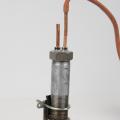Late 1960 zaporozhye plant Kommunar has produced the first series of Zaporozhets cars. The dream of a "people's car" has become a reality. The Soviet car industry fulfilled the dreams of both a peasant car and a car for the party elite.
Zaporozhets
Since the mid-50s, the demand of the population for a compact, inexpensive "people's" car began to take on more and more mass character. The task of creating such was set by the state economic planning authorities for development in the period 1959-1965. It was decided to take the Fiat 600 as the basis for the future car. It must be said that the "humpback" was not a blind copy of the Italian runabout. Many structural units have undergone significant changes. ZAZ 965 became a real "people's car", "starred" in such films as "Three plus two", "Queen of the gas station" and many others. There was a "hunchback" even in the cartoons "Wait a minute" and "Holidays in Prostokvashino".
The Ukrainian auto industry, having experimented on the "hunchback" "Zaporozhets", which was a replica of the six hundredth Fiat, during the years of Brezhnev's rule released a new model, almost a full-fledged, but very compact sedan, in the exterior similar to the Chevrolet Corvair. Distinctive feature The car became large air intakes, which the people immediately christened with ears, from which ZAZ 966 got its nickname. In later models, the ears were cropped, but the nickname remained. "Eared" was the first car of Vladimir Putin, a 19-year-old law student won his first car in the DOSAAF lottery.
ZIL-111

“Catching up and overtaking America” was the main goal in the development of Soviet industry in the 1950-60s. This trend also affected the domestic auto industry, especially its representative segment. The first secretary of the Communist Party of the Soviet Union Nikita Khrushchev wanted the same car as the American president, only better. By the end of the 50s, the "Stalinist" ZIS-110, which served faithfully for 13 years, became morally obsolete and ceased to suit at once for several reasons. Firstly, it outwardly did not in any way correspond to the trends in the development of auto design, and secondly, the ZIS-110 was not a piece, it was produced on an assembly line and filled taxi companies. It is clear that the head of the Soviet Union could not drive the same car with mere mortals. An order was given for the production of a new executive car; the result of this order was the ZIL-111. Suspiciously similar to the American Cadillac, the Zil-111 combined all the best that the auto industry could give: an automatic transmission with push-button control, power windows, a V-shaped eight-cylinder engine, power steering, a four-headlight system and an executive seven-seater interior. During the production of the model, only 112 cars were produced. Interesting fact: when the production of representative cars "Huntsy" began in China, the design of the ZIL-111 was taken as a basis.
"Gull"

The most beautiful car Soviet Union, "Chaika" was the most massive Soviet car executive class... In terms of its external appearance, the car was a compilation of design solutions of the American automobile industry, the so-called fin style, or "Detroit baroque". "The Seagull" can be attributed to the long-livers of the Soviet automobile industry: cars were produced from 1959 to 1981. Heads of ministries and departments, first secretaries of republican communist parties, ambassadors of the USSR abroad traveled on "Chaikas". In addition, several special modifications of the car were produced: filming, semi-phaetons, the case of the production of a railcar on the basis of "GAZ-13" is also known.
Immediately after the start of production of the "Seagulls", a "hunt" began for them - an elegant, comfortable car seduced the party functionaries, but the obsolete ZiM remained the main member of the group. A way out was found: at one of the defense plants, the front and rear parts of the ZiM were welded to the body of the "Chaika". In practice, the result was a camouflaged car of a high level of comfort, popularly nicknamed "Oslobyk". For a long time "The Seagull" was inaccessible to the mass buyer, after two overhauls it was supposed to be disposed of. Only in the 70s did Brezhnev allow making money on the Chaikas: cars began to be widely operated by registry offices, served by Intourist, diplomatic missions of foreign countries, ministers, military parades, Soviet ambassadors abroad and stars visiting the USSR.
Volga

The Volga should be black. The black 24th "Volga" was a symbol of an entire era, which is not surprising - the car was produced from 1970 to 1992. This car was an indicator of well-being and cherished dream every Soviet citizen. The mass sale of Volgas into private hands, however, was never envisaged: most of the cars went to government agencies, taxi companies and for export. Only very wealthy people could afford the Volga, compared to the “people's” “Moskvichs” and “Zhiguli” the nomenclature cars were very expensive. "Volga" were produced in several modifications, the most common was, of course, the sedan. There were fewer station wagons, and almost all of them went to the needs national economy, therefore, for a long time they could be bought either in the shops of the Beryozka chain for checks, or received on an individual order.
VAZ 2101 ("Kopeyka")

VAZ 2101, "Kopeyka" - a legendary car, the most people's car in USSR. The Italian Fiat 124 was taken for the prototype of the first Zhiguli model. True, the Italian was significantly improved, more than 800 changes were made to the Fiat design.
The "unit", as the people called the VAZ 2101 lovingly at first, was a revolutionary car for Soviet motorists. The level of execution and assembly of cars was at a very high level. Suffice it to say that many of the changes introduced by Soviet designers were later used in the production of cars in Italy. "Kopeyka" was a favorite car not only in the Soviet Union, but also in the countries of the socialist bloc. In Cuba, “penny-limousines” are still in use today, which are used as route taxis. In 2000, according to the results of a survey of almost 80 thousand motorists from Russia and the CIS countries, conducted by the magazine "Za Rulem", VAZ 2101 was recognized as "the best Russian car of the century."
VAZ-2108 ("Chisel")

"Eight" was the first front-wheel drive Soviet car. For the domestic automotive industry, it was a revolutionary model. Prior to that, all Zhiguli models were exclusively rear-wheel drive. Some components and assemblies of the VAZ-2108 were developed jointly with the Western companies Porsche and UTS. The amount of the contract between the Minavtoprom and Porsche is unknown. However, rumor has it that the sharpening of the "chisel" allowed the company to build a full-size wind tunnel to replace the squalid climate chamber. For its unusual shape, the "eight" was immediately dubbed the "chisel" among the people, however, despite the nickname, the car "took root". Particularly popular "eight" (and later "nine") earned during the years of perestroika among representatives of the criminals. Frisky front-wheel drive cars with "predatory" outlines - perfect car "Brothers".
VAZ 2121 "Niva"

The task to do four-wheel drive car "Zhiguli" was put before "VAZ" by the chairman of the Council of Ministers of the USSR Alexei Kosygin. The task was not easy, but they coped with it even better than well. "Niva" became the world's first small-class SUV. In fact, it was with the "Niva" that the era of crossovers began. In addition, the Niva was the first permanent all-wheel drive vehicle. The decision on permanent all-wheel drive was made by the designers due to economy in order to reduce the load on the transmission: when assembling the first Soviet jeep, parts from passenger cars "Zhiguli" were used. "Niva" became a very successful model and enjoyed well-deserved love not only in the USSR, but abroad. The export versions of the Niva were thoroughly tuned, the price for them abroad was comparable to the price of Mercedes, the demand was no less. "Niva" was successfully sold in more than 100 countries of the world, it was assembled in six countries: Brazil, Ecuador, Chile, Panama, Greece, Canada. In many countries, there are still clubs of Niva fans, and in England fans of Niva even publish their own magazine.
(all) Modimio AB-Models Autohistory (AIST) AtomBur Autopanorama Agat AGD Arsenal Dealer models BELAZ Star II Imperial Kazan KazLab Kamaz Cimmeria KolkhoZZ Division Companion Handmade Kremlin garage LeRit Lomo-AVM Workshop Kolorovsky Workshop V. Skal "Riga" Maestro-models MD-studio Minigrad Miniklassik Minsk Modelist Modelstroy Moskhimvolokno MTC Models Our Auto industry Our Trucks Our Tanks Ogonyok Print edition Petrograd Prestige Collection Promtractor Other Russian Miniature SarLab Made in the USSR Sergeev Scale SMU-23 Soviet Bus SPBM Start 43 Daimler-Mar Studio JR Studio KAN Studio Wheel Studio (Kiev) Swan Studio MAL / Lermont Studio Tantalum Technopark Universal Uralsky Sokol Kherson Models XCM Chetra Elekon Electropribor 78art Abrex Academy AD-Modum Adler-M AGM Almostreal Amercom Amodel Anson Aoshima Apex Atlas AutoArt Autocult Automaxx Collection Autotime AVD Models Bauer / Autobahn BBR-Models Bburago Best-Model Bizarre Brooklin Brumm BoS-Models Bronco Busch By.Volk Cararama / Hongwell Car Badge Carline Cars Century Dragon Champion R Promo Models ClassicBus Classic Models CM-Toys CMC Cofradis Conrad Corgi Cult Scale Models DNK DeAgostini DelPrado DetailCars Diapet Dinky DiP Models Dragon Eaglemoss Easy Model Ebbro Edison EMC Esval Models Eligor ERTL Exoto Expresso Auto Fine Molds First to Fight First 43 Models First Response Faller FrontiArt Foxtoys Fujimi Gama Garage GATE GATE GreenLight Group Masters GLM-Models GMPt. Hasegawa Heller Herpa Hi-Story HighSpeed \u200b\u200bHobby Boss Highway61 Hot Wheels HPI-Racing ICM ICV IGRA I-Scale IST models Italeri IXO J-collection Jadi Modelcraft Jada Toys Joal Kaden Joy City KESS Model K-Model Kinsmart Kingstar KK Scale Knopp Kyosho La Mini Miniera LS Collectibles LookSmart Lucky Models Luxury Diecast M4 M-Auto Maisto Majorette Make Up Master Tools Matchbox Matrix Maxi Car MCG MD-Models Mebetoys Mikro Bulgaria Minialuxe MiniArt Miniaturmodelle Minichamps ModelPro Mondo Motors MotoScaleModels Mr. Hoby Neo New Ray Nik-models Norev Nostalgie NZG Models Opus studio Oxford Panini Pantheon Paragon Paudi Piko Pino B_D PMC Polar Lights Preiser Premium Classixxs Premium Scale Models Premium X ProDecals Prommodel43 Quartzo Rastar Renn Mini Hoatures OZ City RMZ Retro Trans Models Revell Rextoys Ricko Rietze RIO RO-models Road Champs S&B Creative Studio SAM (ScaleAutoMaster) Saico Schabak Schuco Shelby Collectibles Shinsei Signature Siku Smer Smm Solido Spark Spec Cast Starline Start Scale Models SunnySide Sunstar Tamiya Tin Wizard Tins Toys TMTmodels Tomica Top Marques Trax Triple 9 Collection Trofeu Trumpeter True Scale Minis UltimateMiBbies / VMM V43 Vanguards Vector-models Vitesse Viva Scale Model Welly Wiking WhiteBox War Master WSI Models Yat Ming YVS-Models Zebrano dindon74 c This music will be eternal! (c) Journal 1:24. The test is already running.Already 8 years have passed, as thousands of boys of the 70-80s of the twentieth century, the magazine "Autolegends of the USSR" - returned to the sweet embrace of collectibles, when suddenly, industrial manufacturers of modern models climbed out, who managed to become luminaries, start their own traditions, unleash their "competitive" wars ...
The magazines have grown fat with an assortment - like domestic, like - Super-shivomarki, like - Ferrari with Tractors, well, what you like! And everything is in your favorite, from the 70s and 80s of the "Saratov-Elekon" years, 1/43 scale.
But no! WILL BE LITTLE! LITTLE !!!
"Legendary Soviet Cars". Hachette. Scale 1:24. Test in Voronezh.
Interestingly, there is silence on the Offsite of this very ASHET! There even, about their own "Tractor Journal" and then 0.00 information ... are they ashamed of it, or what? Well, let's spy then, we are no strangers.
What will happen in another 8 years? KrAZ-baker, in the blister of the Magazine, in 1/18 scale ??
Where and how to expand the shelf space?

Meanwhile - here it is, (who would have doubted!) "Our everything!", 21st. Quite to myself, given the RRTs \u003d 699re!

Quite a detail, well, for 700re!

Not filled with paint, the proportions of the eyes do not cut.

Simple, but the hodovka elements are marked.

In two weeks, Voronezh colleague collectors will ask for a new issue in the stalls - "The Seagull", but the rest, in half a year, will they ask for issues of this series? Or will everyone pick out "their own", 1-3 models from the series that were in the family, etc.?
Collect a unique collection of Soviet cars in a unique 1:24 scale with the new magazine series “ Legendary Soviet Cars". Publisher Ashet Collection (Hachette).
You will receive models of both popular and rare cars that have become symbols of a bygone era. Quality metal models mounted on a stand are accompanied by colorful magazines. Archival photographs and rare documents on the pages of the magazine convey the spirit of the past. Meet legendary cars from the Soviet era.

Model Collection 1:24
Collect a unique collection of the most famous models passenger carsproduced in the Soviet Union.
Large-scale, meticulously crafted models allow you to view and compare passenger cars in detail different manufacturers and different generations.

- Accurate metal car copy scale 1:24.
- The interior decoration has been reproduced in great detail.
- Accurately recreated design elements.
- The body is made of metal using die-casting technology.
- The tires are made of high quality rubber.
- Presentation stand.
- Each model is accompanied by a colorful, captivating, information-rich magazine.

The production of a high-quality, finely executed model is a labor-intensive process that involves many specialists of various profiles. It takes more than a year of professional teamwork to create one model.
Detailed model description - Each issue of the magazine includes a detailed layout diagram of the car and its specifications, which allows you to visually show the features of the model.
Journal
Together with by the Legendary Soviet Automobiles magazine you will discover the history of the automotive industry in general and the peculiarities of this industry in the USSR, get acquainted with the vivid personalities of the automobile world, Soviet famous brands and little-known, but no less interesting models. Fascinating, information-rich essays by specialists, detailed diagrams, drawings and unique photographs will help you with this.

- Each issue is dedicated to a specific model of the Soviet passenger car.
- The magazines will tell you about the outstanding achievements of the national automotive industrywill describe the models in detail passenger cars and will recall the names of outstanding design engineers who devoted their lives to the development of Soviet vehicles.
- Articles are accompanied by photographs, drawings, diagrams and archival documents.
The magazine contains six fascinating headings:
- Model number - The history of the creation of the machine, design, features, main technical characteristics and layout diagram.
- Machine and time - Amazing facts from the life of the car, which the collection number is dedicated to.
- History of factories - A story about the construction and activities of automobile factories, where the future legends of the automotive industry came off the assembly lines.
- Portrait - Biographies of prominent figures in the automotive industry, acquaintance with specialists related to the car, which is presented in the magazine.
- Car world - Secrets of invention and improvement of mechanisms, units and machine parts.
- Domestic automotive industry - Information about the development of the Soviet automobile industry, presented in chronological order.
GAZ-21I "Volga" - Strong and durable, with a soft suspension and a comfortable interior, the Volga was the most respectable car in the USSR. It was used by government services: taxi, criminal investigation department, traffic police, etc.
GAZ-13 "Chaika" - This is one of the most famous executive class cars in the USSR. In the "Chaika", the factory designers have used completely new units: an automatic transmission, a power steering, a vacuum brake booster.
GAZ-M20 "Victory" - For the mid-1940s, the Pobeda car was truly revolutionary. The car had a four-door pontoon-type supporting body, which did not have separate fenders, steps and headlights. This and a number of other innovations in the West became widespread only a few years later.
VAZ-2101 "Zhiguli" - was named the best domestic car of the twentieth century. The car was distinguished by comfort, reliability, adaptability to Soviet roads and climate, and relative accessibility. With Volzhsky machines automobile plant new materials and technologies came to the country that helped the Soviet auto industry take a step forward.




